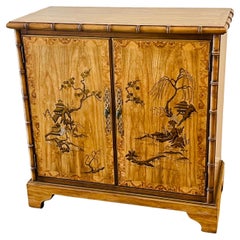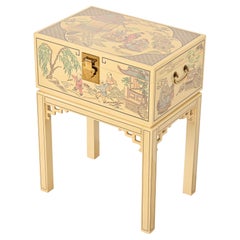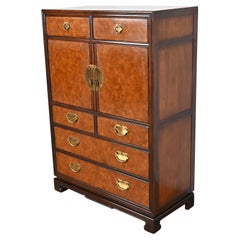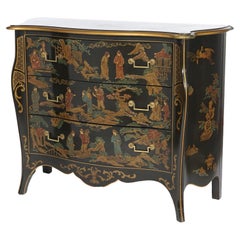Drexel Heritage Chinoiserie Chest
Vintage 1960s American Chinoiserie Commodes and Chests of Drawers
Oak
Late 20th Century American Chinoiserie Side Tables
Mahogany, Lacquer, Paint
Recent Sales
Vintage 1980s American Hollywood Regency Commodes and Chests of Drawers
Brass
20th Century American Chinoiserie Commodes and Chests of Drawers
Wood
Late 20th Century American Chinoiserie Side Tables
Brass
People Also Browsed
Late 20th Century Chinese Chinoiserie Side Tables
Porcelain
21st Century and Contemporary British Chinoiserie Wallpaper
Paper
20th Century Chinese Chinoiserie Wallpaper
Paper
21st Century and Contemporary French Post-Modern Chandeliers and Pendants
Metal
Early 20th Century Italian Rococo Revival Coffee and Cocktail Tables
Poplar
20th Century Japanese Decorative Boxes
Mother-of-Pearl, Wood, Lacquer
20th Century American Mid-Century Modern Vitrines
Vintage 1930s Chinese Chinoiserie Wall-mounted Sculptures
Wood
21st Century and Contemporary British Pillows and Throws
Linen, Nylon
Vintage 1920s English Dinner Plates
Porcelain
Antique 19th Century Central American Napoleon III Wall Lights and Sconces
20th Century Chinoiserie Side Tables
Brass
20th Century American Art Deco Beds and Bed Frames
Leather, Wood
Vintage 1970s American Mid-Century Modern Dressers
Brass
Antique 18th Century French Chinoiserie Paintings and Screens
Silk, Giltwood
Late 20th Century Chinese Chinoiserie Paintings and Screens
Paper
Drexel for sale on 1stDibs
While vintage Drexel Furniture dining tables, dressers and other pieces remain highly desirable for enthusiasts of mid-century modern design, the manufacturer's story actually begins decades before its celebrated postwar-era Declaration line took shape.
In 1903, in the small town of Drexel in the foothills of North Carolina’s Blue Ridge Mountains, six partners came together to found a company that would become one of the country’s leading furniture producers. The first offerings from Drexel Furniture were simple: a bed, washstand and bureau all crafted from native oak wood, sold as a bedroom suite for $14.50.
One of Drexel’s early innovations was to employ staff designers, something the company initiated in the 1930s. This focus on design, which few other furniture companies were committing to at the time, allowed Drexel to respond to a variety of new and traditional tastes. This included making pieces inspired by historic European furniture, like the popular French Provincial–style Touraine bedroom and dining group that borrowed its curves from Louis XV-era furniture. Others replicated the ornate details of 18th-century chinoiserie or the embellishments of Queen Anne furniture. Always ready to adapt to new customer demands, during World War II, Drexel built a sturdy desk designed especially for General Douglas MacArthur.
In the postwar era, Drexel embraced the clean lines of mid-century modernism with the Declaration collection designed by Stewart MacDougall and Kipp Stewart that featured elegant credenzas and more made in walnut, and the Profile and Projection collections designed with sculptural shapes by John Van Koert. In the 1970s, Drexel introduced high-end furniture in a Mediterranean style.
Drexel changed hands and visions throughout the years. It was managed by one of the original partners — Samuel Huffman — until 1935, at which time his son Robert O. Huffman took over as president. It was then that the company began to expand, with several acquisitions of competitors in the 1950s, including Table Rock Furniture, the Heritage Furniture Co. and more.
With the manufacturer’s success — spurred by its embrace of advertising in home and garden magazines — it opened more factories in both North and South Carolina. By 1957, the company that had started with a factory of 50 workers had 2,300 employees and was selling its furniture nationwide.
Drexel underwent a series of name changes in its long history. Its acquisition of Southern Desk Company in 1960 bolstered its production of institutional furniture for dormitories, classrooms, churches and laboratories.
In the following decades, contracts with government agencies, hotels, schools and hospitals brought its high-quality furniture to a global audience. U.S. Plywood-Champion Papers bought Drexel Enterprises in 1968, and it became Drexel Heritage Furnishings.
In 2014, the last Drexel Heritage plant, in Morganton, North Carolina, closed its doors. The company rebranded as Drexel in 2017.
The vintage Drexel furniture for sale on 1stDibs includes end tables designed by Edward Wormley, walnut side tables designed by Kipp Stewart and lots more.
A Close Look at Chinoiserie Furniture
Emerging in the 17th century, chinoiserie appropriated the aesthetics and imagery of popular East Asian design for European-made versions. Reflecting the exoticization of China, Japan and other countries in this era, the word directly translates from French to “Chinese-esque,” which reveals its shortcomings as a style of furniture and decor that often stereotypically and reductively mimics Asian culture rather than showcasing and paying tribute to its artistic traditions.
The enthusiastically decorative chinoiserie style was propelled by influential tastemakers including French King Louis XIV, whose Trianon de Porcelaine in 1670 was inspired by Chinese architecture. Expanded trade between the East and West led to a demand for porcelain, lacquer objects, silk and other goods, which further informed the fanciful furniture being crafted in Europe.
Artisans working in the chinoiserie style used materials and elements like pagoda shapes, bamboo, lacquer surfaces, bird and flower motifs and other interpretations of Asian design on pieces that were frequently set against vibrant wallcoverings. This whimsical approach yielded chinoiserie furniture that boasted dramatic flourishes drawing on the natural world and reflected the dominance of Rococo during the 18th century.
As chinoiserie was shaped by approximations of Asian design by European creators, it had regional variations, such as Chinese Chippendale in England where cabinets, chairs and tea tables had wooden fretwork designs and “japanned” surfaces intended to resemble lacquer work that was created in East Asia. In North America, furniture makers in Boston and New York integrated chinoiserie-painted scenes into Queen Anne furniture.
Antique chinoiserie furniture has continued to be fashionable, from its popularity with decorators of the Hollywood Regency era — James Mont, Tommi Parzinger, William Haines and Samuel Marx favored the style — to contemporary interior designers, although it brings with it a complex history.
Find a collection of chinoiserie bedroom furniture, cabinets, decorative objects and more on 1stDibs.
- 1stDibs ExpertSeptember 25, 2024Yes, Drexel Furniture is good quality, and owing to the commendable level of craftsmanship that characterizes the company's work, Drexel's furnishings typically retain or increase in value over time. Vintage Drexel dining tables, dressers and other pieces remain highly desirable for enthusiasts of mid-century modern design.
The North Carolina manufacturer initially became known for pieces inspired by historic European furniture. In the postwar era, Drexel adapted to changing tastes and embraced the clean lines of mid-century modernism with the Declaration collection designed by Stewart MacDougall and Kipp Stewart that featured elegant credenzas and more made in walnut. The Profile and Projection collections of the period, designed with sculptural shapes by John Van Koert, also see demand on today’s secondary market.
Find vintage Drexel Furniture for sale on 1stDibs.



